Dai-ichi Life Insurance Company Using HULFT
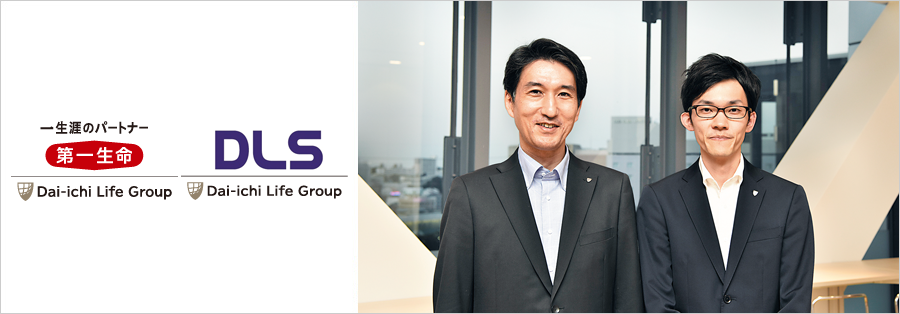
Increased System Flexibility, Consistent Security: HULFT Provides the Building Blocks for File Integration Infrastructure
Serving over 10 million individual customers, the Dai-ichi Life Insurance Company, Limited is a leading life insurance company in Japan. The company chose HULFT as their standard tool for file transfer between various in-house IT systems and for their external communications, while they rely on HULFT-HUB to build their internal infrastructure for file integration. In addition, DataMagic has enabled them to perform code conversion between mainframe systems and open systems. By using the solutions provided by Saison Information Systems, they succeeded in integrating their separate file transfer systems for internal and external use.
USER PROFILE
Founded in 1902 as the first mutual insurance company in Japan. The mission statement of the Dai-ichi Life Group, "Customer First," has been in use for more than 115 years since its foundation. Even now it is still ingrained in each employee's mind and is a core principle of its business activities. The Dai-ichi Life Information Systems is responsible for the IT strategy of the Dai-ichi Life Group and for both system solutions and office services, developing and operating a large number of IT systems that answer the needs of a variety of insurance business activities.
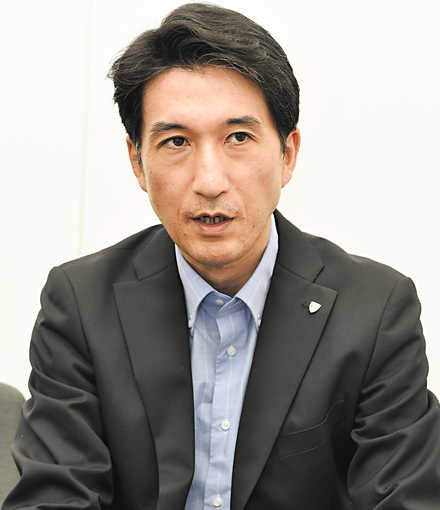
Mr. Eita Yoshidome
Deputy General Manager, IT Operations Management Div.
IT Business Process Planning Dept.
The Dai-ichi Life Insurance Company, Limited

Mr. Tatsuya Takano
Leader, Infrastructure Systems Development Group No.2
Infrastructure Systems Dept. No.1
The Dai-ichi Life Information Systems Co.,Ltd.
Background: In Need of a Quick Solution—Preparing a File Integration Infrastructure for Use with the My Number System
The Dai-ichi Life Insurance provides life insurance and related services for both domestic and international markets, fueled by their mission statements "By your side, for life" and "Customer First." Offering products and services that meet the needs of this day and age, their aim is to improve each individual customer's QOL (Quality of Life). In their mid-term business plan CONNECT 2020, which is currently in the works, they lay out an ambitious framework for their future business activities: stimulating innovation to expand their life insurance activities overseas, asset management activities, and business automation, while keeping the domestic market for life insurance at the heart of their business. The company strives to improve product strategies that contribute to the improvement of their customers' QOL.
Mr. Eita Yoshidome is Deputy General Manager of the IT Operations Management Division within the IT Business Process Planning Department of the Dai-ichi Life Insurance. He recalls a time when they used various other solutions for file transfer, as they had to deal with dispersed in-house systems and external file transfer destinations. "Although our infrastructure involved a mixture of different systems, we had devised an in-house procedure for starting application development in order to standardize our file transfer methods and operations as much as possible. We understood that it would be much easier if we standardized our infrastructure as well. This posed a challenge. If we could realize complete standardization, we could quickly adapt to change with the times and greatly increase the flexibility with which we conducted our operations."
Against this background, the company only needed the impetus to make the change, which they found when the new social security number system in Japan, called My Number, came into effect. They began to consider standardizing their file transfer systems, followed by the installation of a central hub around which they could build an infrastructure for file integration.
Serving over 10 million individual customers, the Dai-ichi Life Insurance is a leading life insurance company in Japan. The company chose HULFT as their standard tool for file transfer between various in-house IT systems and for their external communications, while they rely on HULFT-HUB to build their internal infrastructure for file integration. In addition, DataMagic has enabled them to perform code conversion between mainframe systems and open systems. By using the solutions provided by Saison Information Systems, they succeeded in integrating their separate file transfer systems for internal and external use.
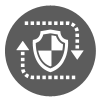
Realized
secure and flexible
file integration
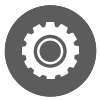
Centralized management
of data accumulation, logs, etc.

Constructed an environment for
high-volume file transfer
Introduction: An Excellent Track Record in the Life Insurance Industry and High Hopes for Simplified Operations Proved Deciding Factors
It was around this time that the company set their sights on HULFT, an IT solution which has made significant achievements in various segments including the insurance industry. Mr. Tatsuya Takano is the Leader of the Infrastructure Systems Development Group No. 2 of the Infrastructure Systems Department No. 1 of the Dai-ichi Life Information Systems Co.,Ltd. His group mainly operates the systems for external file transfer. "Before we considered HULFT for use with our My Number operations, we were already using the software for our file transfers with external companies," he explains. Because of its good reputation both inside and outside the company, HULFT was considered as a candidate from early on.
What they particularly liked about HULFT was its emphasis on safety regarding file integration. "The amount of data transfer over the internet will increase, so we wanted the file integration system itself to have a mechanism that enables encryption." The systems for external file transfer which they had previously been using did not have encryption capability. In addition, the company also considered switching to HULFT because their existing systems for internal file transfer did not support high-volume file transfer.
Another deciding factor was the prospect of using HULFT-HUB, which would enable centralized management. "To update definitions in several systems at once, I only need to distribute them once through HULFT-HUB. I can also manage logs from a centralized location," says Mr. Takano. Mr. Yoshidome, who for years has been in charge of IT infrastructure, adds: "We needed a system that would make integration easy and that would work reliably."
As a result, the company chose HULFT and HULFT-HUB to build their desired common infrastructure for internal and external file transfer, and DataMagic as a much-needed solution for character code conversion during file exchanges between mainframe systems and open systems.
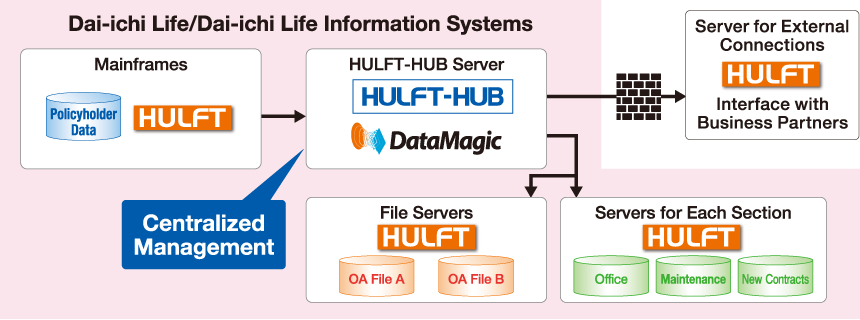
Result: HULFT Provided the Infrastructure That Guaranteed Security for Internal and External File Transfer
At the time of writing, the Dai-ichi Life Insurance Company has installed HULFT-HUB as the file integration infrastructure in over 100 environments. As their next step, the company plans to sequentially implement HULFT in systems that require file transfer when they come up for renewal. "Eventually we plan to introduce HULFT into around 300 or 400 systems, which would mean a fourfold increase in the scale at which it is currently operating. Within the next few years we will be able to establish a file integration infrastructure that is centered on HULFT-HUB. Thanks to HULFT, we've been able to lay the foundation for a secure and reliable infrastructure," says Mr. Yoshidome.
For the transition from their existing systems, despite some difficulties such as the limitations of the code conversion table, the company is getting positive reviews about the new infrastructure's capabilities for guaranteed secure file integration. "We can keep using the same file names that we had been using before, and so we are also getting favorable responses from our application development teams," says Mr. Takano. Not only has system integration become a relatively easy process, it is now also possible to integrate external systems by adjusting a minimal number of settings. "There are many settings, but that means we can choose which settings to adjust while making sure performance doesn't suffer. This is just one of the many features that makes HULFT a very comprehensive product," is Mr. Takano's appraisal.
Mr. Yoshidome points out that guaranteed secure file transfer was one of the major achievements that were made possible by HULFT. "We now have the ability to better manage risks that might come up in the future. This is a very important point. We have arrived at the point where we can transfer files effortlessly without the need to be aware of our infrastructure—it feels as easy as using electricity, gas, or tap water."
What struck Mr. Takano was the ease with which he can investigate errors. "I can use the GUI of HULFT-HUB Manager to immediately start an investigation and it will provide me with a detailed record, which even shows the cause of the error. Without a doubt, the speed at which we can get answers has increased," he explains. According to Mr. Takano, as long as the definition files for file transfer are created in CSV-format, they can be applied in one go to all environments, so that even if the number of file transfer destinations were to increase in the future, systems will not be strained and the operational efficiency will not be affected.
Mr. Yoshidome says that a specific plan has not yet been made, but the company also anticipates increased cloud use, which will create a need for tools to securely transfer files, such as HULFT. Making use of the data accumulation function that HULFT-HUB provides, the company has also set up an environment that can be used for communication with overseas contacts when there is a time difference. Currently, file integration is limited to domestic destinations, but they are in the process of setting up an infrastructure that will allow them to expand their global activities.
From an operation standpoint, Mr. Takano says he looks forward to HULFT further evolving into a system that will be even easier to use. "We will likely use HULFT to an even greater extent as we see changes in our IT environment—for example when support will end for basic mode control procedures within the Zengin TCP/IP Procedure and Zengin protocols. As an operator I'm really looking forward to seeing what other user-friendly functions are implemented by HULFT," he concludes.
Notes:
- HULFT and other products related to HULFT are registered trademarks or trademarks of Saison Information Systems Co., Ltd.
- The company names and product names mentioned in this document are trademarks or registered trademarks of their respective companies.
- Trademark symbols (TM, ®) might not be appended to the system names, product names, etc., mentioned in this document.
